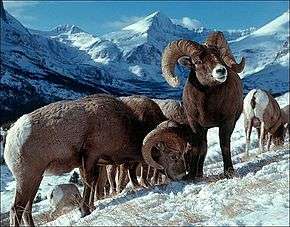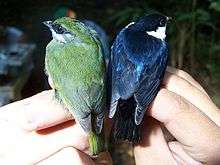Altitudinal migration
Altitudinal migration is a short-distance animal migration from lower altitudes to higher altitudes and back.[1][2] It is commonly thought to happen in response to climate and food availability changes as well as increasingly due to anthropogenic influence.[3][4] These migrations can occur both during reproductive and non-reproductive seasons.[5] Altitudinal avian migration is common, and can also be found in other vertebrates, and can be seen in some invertebrates.[3][6]

Typical characteristics of tropical altitudinal migrants include: a high rate of frugivory or nectarvory; movement between lower elevation areas during non-breeding seasons and higher elevation areas during breeding seasons, or on a consistent annual or seasonal cycle; at least part of the population being migratory with a possible portion of the population residing at breeding sites year-round. This last characteristic can be sex-biased, as it is with juncos, in which the males are less likely to migrate than the females. The white-ruffed manakin provides a good example of an altitudinal migrant by displaying all of these traits. It has a high rate of frugivory, migrates from lower elevations to higher elevations on a predictable breeding-season based cycle, and part of the population is migratory, with a small portion possibly remaining at the breeding sites year-round.[7]
Regions
There are many documented examples of migratory range shifts along an elevation gradient among temperate species. While these migrations are more understood in temperate regions, and far less understood among tropical ecosystems and species, there are documented cases.[8] Altitudinal migration is typically seen among taxa found in montane areas.[2] Generally, as elevation increases, the species richness decreases.[9]
Tropics

In the tropics, altitudinal migrations are most commonly seen among frugivores or nectarvores, such as what is seen among tropical hummingbirds, which migrate altitudinally in response to shifts in food abundance and availability.[3] This migration pattern has been observed in neotropical birds, but has also been seen in other terrestrial, tropical montane species such as Baird's tapir and white-lipped peccary.
Tropical avian species that are altitudinal migrants include the white-ruffed manakin, resplendent quetzal, at least 16 species of raptor, and many species of hummingbird.[3][10]
Altitudinal migration has also been witnessed in some tropical bat species. As of 2014, there is not much information as to why tropical species migrate altitudinally, other than that it may be for food resources or reproduction, as it is for temperate bat species.[6]
Temperates
While less common in avian species in the temperate regions, altitudinal migration still plays a part in migration patterns in montane zones and is seen in most ungulates in the Rocky Mountains.[1][11] Avian temperate species that migrate altitudinally include mountain chickadee, and the American dipper.
Ungulates that have been observed to migrate altitudinally include roe deer, bighorn sheep, and mountain goats.
Temperate bat species are also altitudinal migrants. Their migratory patterns are sex-biased altitudinal migrations, with females inhabiting lower elevations during reproductive periods.[6]
Causes
Altitudinal migration, as a short-distance migration pattern, has been easier to trace than long-distance patterns. Still, while the proximate causes and physiological adaptations for migrations are well understood, determining the ultimate causes have been difficult.[1] This difficulty has been linked to limited success of mark and recapture techniques used to track migratory species.[3][12] There are many hypotheses for why altitudinal migration may occur, including correlations between food abundance and nutrition-the need to migrate in order to meet specific needs associated with varying abundance and nutrition; reproduction-breeding sites being at elevations different than those of non-breeding sites; anthropogenic-species being increasingly driven to higher altitudes due to human actions.
Food abundance and nutrition
Migration in response to food abundance has been the most accepted hypothesis for why species migrate altitudinally.[1] This hypothesis states that peaks in food abundance along an elevational gradient, such as the slope of a mountain, drive migration patterns as species exploit available food resources.[13] Peaks in food abundance along this gradient often coincide with the breeding season.[1] Some frugivorous birds, such as white-ruffed manakins (Corapipo altera) migrate to higher elevations to exploit peaks in fruit abundance.[13] Evidence supports the possibility that migrants have a competitive advantage compared to non-migrant (sedentary) species, due to increased foraging ability over a larger area, resulting in greater food and nutrient uptake.[1] It's been shown that diet differs between non-migratory and migratory species in large-scale analyses and species-pair comparisons of frugivorous tropical birds.[7]
While this hypothesis is supported, and has been the most accepted, it fails to explain why altitudinal migrants return to lower elevations, or if it is done in response to shifting food resources.[1] It has been proposed that weather-related resource availability may trigger the elevational migration of some species, such as the white-ruffed manakin during storms.[2]
Reproduction
A number of species engage in movement that could be defined as altitudinal migration as part of their mating or reproductive behaviors.
For example, in male white-ruffed manakins, migratory behavior has shown to lessen social status and mating success at leks the following breeding season.[14]
Most hummingbird species at Monteverde increase altitude during the wet season in order to breed.[15]
Of the 16 species of neotropical raptors (including the Andean condor Vultur gryphus), that are known to be altitudinal migrants, most breed in the high Andes and migrate to lowland areas during non-breeding seasons.[10]
Nest predation
Studies have shown a decreased risk of nest predation at higher altitudes, which may explain the seasonal (breeding season—non-breeding season) altitudinal migration of some passerine birds. An experiment using 385 nests at varying locations on the Atlantic slope of Costa Rica showed decreased predation at increasing altitudes, with predation highest at intermediate altitudes. This hypothesis proposes that altitudinal migration may have evolved among some species as a response to nest predation, as a way lower the risk. Studies have also shown that elevation of home range influences breeding time.[16]
Anthropogenic
The walia ibex (Capra walie) has increasingly been driven to higher altitudes in Ethiopian mountain ranges. This has occurred because of human activity impacting their native range, including war, expanding human settlement, and cultivation.[4]
Conservation implications
Climate change
Climate change could be causing migration patterns to shift into an earlier time frame, coinciding with an earlier start of the growing period.[17][18] This means that migratory species may leave lower altitudes for higher-altitude breeding sites while those breeding sites still lack the necessary resources. Some species that have shorter migratory paths may be able to return to the lower elevations and wait, but run the risk of running out of the resources in that lower altitude, such as food and cover, that may only be available for a short, set period of time.[17]
Over 30% of birds and other species in montane forests show altitudinal migration patterns.[19] Because of this, changes in climate and seasonality (decrease or increase) would affect a large portion of tropical species and have the potential to cause a trophic cascade on the community-level.
Furthermore, climate change may cause seasonal storms and rainfall patterns to change, shifting the timing and/or need for altitudinal migration in the future by shifting availability of resources, which is believed to be a driving cause of altitudinal migration.[1][2][13]
The upward shift of species caused by climate change also holds the potential to cause both mountaintop extinction and lowland biotic attrition. This is because the lowland tropics lack species that can cope with increasing temperatures. An overall loss of species richness can occur due to there being fewer migratory species to replace lost ones.[15]
This has been seen occurring by looking at the average time of arrival and departure at high altitude areas for the American robin (Turdus migratorius). The average time interval has shifted by as much as two weeks due to the change in seasonal patterns of resource abundance and temperature.[17]
Migrational corridors
Migrational corridors, connecting lowland and montane habitats are essential for the upkeep and survival of migratory species. Some species can cross cleared lands, suchs as pastures, but many require closed forest areas, such as what is provided by these migrational corridors.[20]
Seed dispersal
Tropical frugivorous birds have complex elevational migrations and are responsible for the dispersal of many species of seeds across the different Holdridge life zones and transitional regions, causing wide dispersal of plant species and significant ecological linkage.[21] A change in migration patterns can cause a decrease in the efficiency, and ability of these species as seed dispersal agents.
See also
- Transhumance-the seasonal movement of people and livestock between winter and summer pasture
References
- Boyle, W. Alice; Conway, Courtney J.; Bronstein, Judith L. (13 July 2013). "Why do some, but not all, tropical birds migrate? A comparative study of diet breadth and fruit preference". Evolutionary Ecology. 25: 219–236. doi:10.1007/s10682-010-9403-4.
- Boyle, W. Alice; Norris, Ryan D.; Guglielmo, Christopher G. (2010). "Storms drive altitudinal migration in a tropical bird". Proc. R. Soc. B. 277 (1693): 2511–2519. doi:10.1098/rspb.2010.0344. PMC 2894928. PMID 20375047.
- Hobson, Keith A.; Wassenaar, Len I.; Milá, Borja; Lovette, Irby; Dingle, Caroline; Smith, Thomas B. (20 May 2003). "Stable isotopes as indicators of altitudinal distributions and movements in an Ecuadorean hummingbird community". Community Ecology. 136 (2): 302–308. Bibcode:2003Oecol.136..302H. doi:10.1007/s00442-003-1271-y. PMID 12756525.
- Fothergill, Alastair (2006). Planet Earth: The Future-Saving Species. BBC Natural History Unit.
- Park, Chris (2007). A Dictionary of Environment and Conservation. University of Florida: Oxford University Press. doi:10.1093/acref/9780198609957.001.0001. ISBN 9780198609957.
- McGuire, Liam P.; Boyle, W. Alice (11 March 2013). "Altitudinal migration in bats: evidence, patterns, and drivers". Biological Reviews. 88 (4): 767–786. doi:10.1111/brv.12024. hdl:2097/17273. PMID 23480862.
- Boyle, W. Alice (24 July 2008). "Partial migration in birds: tests of three hypotheses in a tropical lekking frugivore". Journal of Animal Ecology. 77 (6): 1122–1128. doi:10.1111/j.1365-2656.2008.01451.x. PMID 18657208.
- Lovejoy, Thomas E.; Lee, Hannah (2005). Climate Change and Biodiversity (1 ed.). New Haven: Yale UP. ISBN 978-0300119800.
- Thiollay, Jean-Marc (July 1996). "Distributional patterns of raptors along altitudinal gradients in the northern Andes and effects of forest fragmentation". Journal of Tropical Ecology. 12 (4): 535–560. doi:10.1017/s0266467400009767.
- Bildstein, Keith L. (2004). "Raptor migration in the neotropics: patterns, processes, and consequences" (PDF). Ornitologia Neotropical. 15 (Supplement): 83–99. Retrieved July 21, 2015.
- Festa-Bianchet, M. (1988). "Seasonal Range Selection in Bighorn Sheep: Conflicts between Forage Quality, Forage Quantitiy, and Predator Avoidance". Oecologia. 75 (4): 580–586. Bibcode:1988Oecol..75..580F. doi:10.1007/BF00776423. PMID 28312434.
- Fraser, Kevin C.; Kyser, T. Kurt; Ratcliffe, Laurene M. (May 2008). "Detecting Altitudinal Migration Events in Neotropical Birds using Stable Isotopes". Biotropica. 40 (3): 269–272. doi:10.1111/j.1744-7429.2008.00408.x.
- Boyle, W. Alice (3 February 2010). "Does food abundance explain altitudinal migration in a tropical frugivorous bird?". Canadian Journal of Zoology. 88 (2): 204–213. doi:10.1139/Z09-133.
- Boyle, W. Alice; Guglielmo, Christopher G.; Hobson, Keith A.; Norris, D. Ryan (November 2014). "Lekking birds in a tropical forest forego sex for migration". Biology Letters. 7 (5): 661–663. doi:10.1098/rsbl.2011.0115. PMC 3169044. PMID 21471048.
- Colwell, Robert K.; Brehm, Gunnar; Cardelús, Catherine L.; Gilman, Alex C.; Longino, John T. (10 October 2008). "Global Warming, Elevational Rage Shifts, and Lowland Biotic Attrition in the Wet Tropics". Science. 322 (5899): 258–261. Bibcode:2008Sci...322..258C. doi:10.1126/science.1162547. PMID 18845754.
- Boyle, W. Alice (10 January 2008). "Can variation in the risk of nest predation explain altitudinal migration in tropical birds?". Oecologia. 155 (2): 397–403. Bibcode:2008Oecol.155..397B. doi:10.1007/s00442-007-0897-6. PMID 18188606.
- Inouye, David W.; Barr, Billy; Armitage, Kenneth B.; Inouye, Brian D. (15 February 2000). "Climate change is affecting altitudinal migrants and hibernating species". PNAS. 97 (4): 1630–1633. Bibcode:2000PNAS...97.1630I. doi:10.1073/pnas.97.4.1630. PMC 26486. PMID 10677510.
- Butler, Christopher J. (4 July 2003). "The disproportionate effect of global warming on the arrival dates of short-distance migratory birds in North America". Ibis. 145 (3): 484–495. doi:10.1046/j.1474-919x.2003.00193.x.
- Loiselle, Bette A.; Blake, John G. (1 February 1991). "Temporal Variation in Birds and Fruits Along an Elevational Gradient in Costa Rica". Ecology. 72 (1): 180–193. doi:10.2307/1938913. JSTOR 1938913.
- Loiselle, Bette A.; Blake, John G. (December 1992). "Population Variation in a Tropical Bird Community". BioScience. 42 (11): 838–845. doi:10.2307/1312083. JSTOR 1312083.
- Nadkarni, Nalini; Wheelwright, Nathaniel T. (2000). Monteverde: Ecology and Conservation of a Tropical Cloud Forest (1 ed.). New York: Oxford UP. ISBN 978-0-19-509560-9.